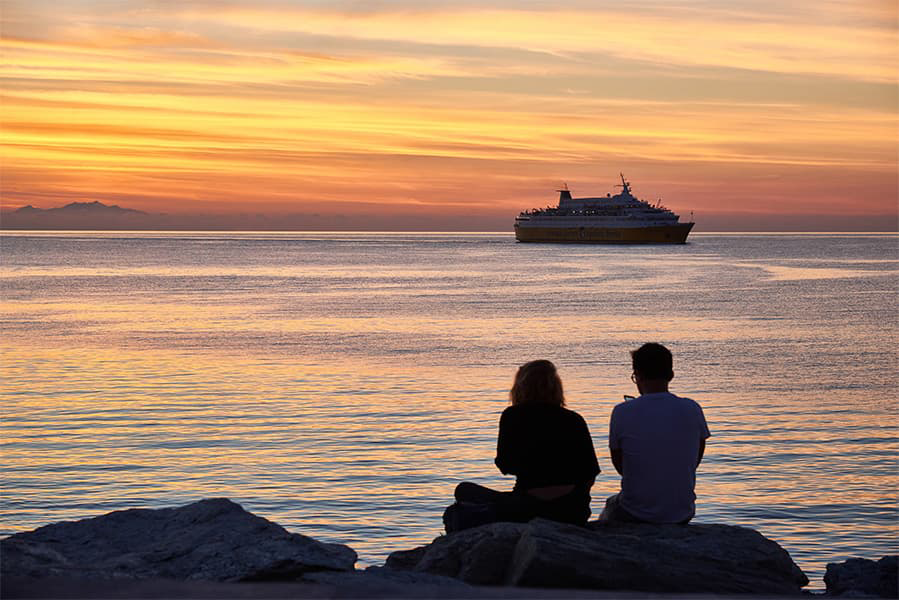Cavo – Portoferraio
Ferries to Elba
Cavo – Portoferraio
Ferries to Elba

There are usually 3 daily and 18 weekly sailings between Cavo and Portoferraio. This ferry route is operated by
The earliest Cavo Portoferraio ferry sailings typically depart Cavo at around 09:00. The last ferry usually departs at 16:25.
Cavo Portoferraio Ferry sail durations on this ferry route can take around 20m. The fastest sailings are approximately 20m. Sailing times can vary, durations often differ between ferry operators and can be impacted by weather conditions.
There are an average of 3 daily sailings and up to 18 weekly ferry sailings from Cavo to Portoferraio. These sailings are provided by Toremar. Please keep in mind that ferry timetables often increase during the high season.
Cavo Portoferraio ferry prices typically range between 60.0 €* and 60.0 €*. The average price is typically 60.0 €*. The cheapest Cavo Portoferraio ferry prices start from 60.0 €*. The average price for a foot passenger is 60.0 €*.
Pricing will vary depending on number of passengers, vehicle type, route and sailing times. Prices exclude service fees.
The distance between Cavo to Portoferraio is approximately 7.6 miles (12.2km) or 6.6 nautical miles.
No, ferry operators currently do not allow cars to travel on sailings between Cavo and Portoferraio
Yes, foot passengers can travel with
Pets are currently not allowed on board the ferries from Cavo to Portoferraio.
More routes than anyone else.

Compare fares, times & routes in one place.
Change plans easily with flexi tickets.

Book e-tickets & manage trips in-app.
Live ship tracking & real-time updates.

Top-rated customer support when you need it.
| Cavo - Portoferraio Route summary | ||
|---|---|---|
| Departure Country | Italy | |
| Destination Country | Italy | |
| No. of Operators | 1 | |
| Operators | Toremar | |
| Average Price | 60 €* | |
| Average Daily Sailings | 3 | |
| Average Weekly Sailings | 18 | |
| Average Sailing Duration | 20m | |
| First Ferry | 09:00 | |
| Last Ferry | 16:25 | |
| Distance | 6 nautical miles | |
* Prices subject to change, pricing is taken from last 30 days, last updated 2024-11-05.
Located on the Italian island of Elba, Cavo is a town and port that lies on the island's Mediterranean Sea coast. Elba is the largest of the Tuscan Archipelago islands and forms a part of the Archipelago Toscano National Park. Elba is also the third largest Italian island after Sicily and Sardinia.
The island is renowned for its crystal clear waters, beautiful beaches and its wonderful landscape on both land and sea. The island is definitely a must see destination for any visitors to Tuscany. For visitors who want to do more than relax on one of the island's beaches, then the island is the perfect destination for scuba diving or snorkelling thanks to its rich waters teeming with many species of fish. For visitors that prefer to stay on dry land then a hike or a mountain bike ride up into the mountains may be in order, or alternatively a sedate round of golf.
The island is connected to the Italian mainland on routes between Piombino and Portoferraio, the capital located in the north, and Cavo, Rio marina and Porto Azzurro, on the east coast of the island.
The town of Portoferraio is located on the north east coast of the Italian island of Elba, on a headland that closes the gulf towards the north. Portoferraio is one of the island's most ancient towns and can trace its origins back to the Ligurians, the Etruscans and the Greeks, before finally becoming a Roman colony named Fabricia. Cosimo I dei Medici is responsible for the town's layout who began to change it after 1548, when the town's name was changed to Cosmopoli, in order to strengthen the town's defences. Popular attractions in or near the town include the Romanesque Church of Santo Stefano alle Trane, the Villa dei Mulini and Villa San Martino, the Etruscan Fortress of Castiglione, the Pinacoteca Foresiana, the International Art Centre of Italo Bolano and the Botanical Garden at Ottone.
A few kilometers from Portoferraio, towards Bagnaia, in the hamlet of Le Grotte, where visitors can see the remains of a Roman villa from the Imperial period. These were covered by plants and shrubs until 1960 when digging brought to light the great complex with walls in opus reticulatum, big terraces overlooking the sea and a pool with heating and a water circulation system.